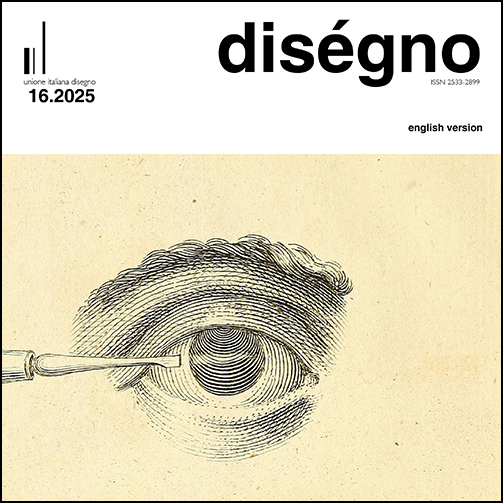The Songe, the Kanagawa’s Great Wave and ISOTYPE. Notes on Drawing as a Natural, Cultural and Universal Language
DOI:
https://doi.org/10.26375/disegno.16.2025.6Keywords:
natural language, cultural language, universal language, learning, communicationAbstract
The contribution proposes a theoretical framework for the analysis of drawing, rooted within the studies of psychology and enriched by significant experiences of visual communication, both contemporary and historical. This approach is justified by considering architectural drawing as a specific declination of drawing understood as a broad language, thus allowing many fundamental observations on the nature, functions and processes of drawing already explored in general contexts to be transferred to the field of architecture.
Relevant examples will be shown that illustrate the three main dimensions of drawing as a natural, cultural and universal language, with particular attention to some studies from the 1960s and 1970s that, although partly outdated, are still fundamental in the study of images and drawings.
The overall theoretical framework will then be declined in the specific context of architectural drawing, highlighting how it incorporates and utilises the three linguistic dimensions outlined above in an integrated manner.
The contribution will conclude with an articulated definition of the distinctive features of drawing understood as a natural, cultural and universal language, laying the foundations for future theoretical and practical reflections on drawing understood as a language.
References
Anceschi, G. (1992). L’oggetto della raffigurazione. Milano, IT: Etaslibri.
Arnheim, R. (1954). Arte e percezione visiva. Milano: Feltrinelli.
Bertin, J. (1967). Sémiologie graphique: Les diagrammes, les réseaux, les cartes. Paris: Gauthier-Villars.
Case, R., Okamoto, T. (1997). The Role of Central Conceptual Structures in the Development of Children’s Thought. Chicago: University Of Chicago Press.
Di Napoli, G. (2011). Che cos’è un disegno e perché si disegna. In Rivista di estetica, 47, 61-81. https://doi.org/10.4000/estetica.1955.
de Rubertis, R. (1994). Il disegno dell’architettura. Carocci: Roma.
Durand, G. (2013). Le strutture antropologiche dell'immaginario. Introduzione all'archetipologia generale (2a edizione; edizione originale pubblicata nel 1973). Dedalo: Bari.
Freud, S. (2010). Tratti arcaici e infantilismo del sogno. In Introduzione alla psicoanalisi. Prima e seconda serie di lezioni, pp. 186-198. Torino: Bollati Boringhieri.
Kennedy, J.M., Ross, A.S. (1975). Outline picture perception by the Songe of Papua. In Perception, 4, 391-406. https://doi.org/10.1068/p040391.
Kellogg, R. (1969). Analisi dell’arte infantile. Una fondamentale ricerca sugli scarabocchi e i disegni dei bambini. Milano: Emme Edizioni.
Lowenfeld, V., Brittain, W.L. (1967). Creatività e sviluppo mentale. Firenze: Giunti.
Luquet, G.H. (1969). Il disegno infantile. Educazione all’immagine per la scuola materna ed elementare. Roma: Armando.
Luigini, A., Moretti, M. (2019). L’attualità di Otto Neurath. Da ISOTYPE al Visual Journalism per un racconto visuale della società. In XY. Studi sulla rappresentazione dell’architettura e sull’uso dell’immagine nella scienza e nell’arte, 3(6), 74-93. https://doi.org/10.15168/xy.v3i6.112.
Menchetelli, V. (2013). Ubiquità di un’atopia. Il linguaggio universale Isotype e la riforma della comunicazione visiva. In P. Belardi, A. Cirafici, A. di Luggo et al. (Eds.), Atopie, pp. 159-164. Roma, IT: Form Act.
Pizzo Russo, L. (2015). Genesi dell'immagine. Milano: Mimesis.
Willats, J. (2005). Making sense of children’s drawings. Leicester: Institute of Education, University of Leicester.
Downloads
Published
How to Cite
Issue
Section
License
Copyright (c) 2025 diségno

This work is licensed under a Creative Commons Attribution 4.0 International License.






